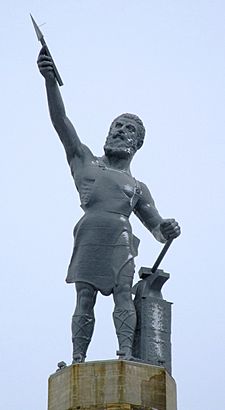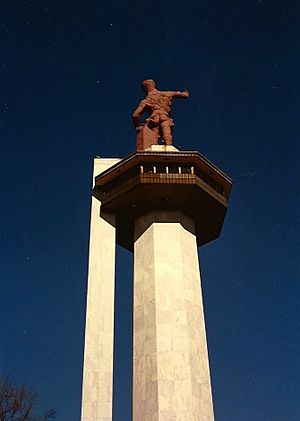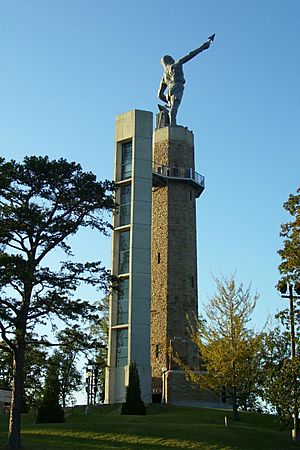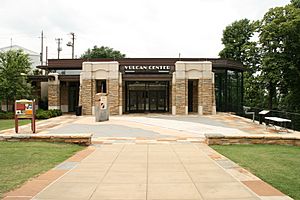Vulcan statue facts for kids
Quick facts for kids |
|
|
Vulcan statue
|
|

Vulcan
|
|
| Location | Red Mountain, Birmingham, Alabama |
|---|---|
| Area | 4 acres (1.6 ha) |
| Built | 1904, 1939 |
| Sculptor | Giuseppe Moretti |
| NRHP reference No. | 76000333 |
| Added to NRHP | July 6, 1976 |
The Vulcan statue is a huge statue made of cast iron, which is a type of metal. It's the biggest cast iron statue in the whole world! This amazing statue is a symbol for the city of Birmingham, Alabama. It shows how important the iron and steel industry was to Birmingham's history. The statue is about 56-foot (17 m) tall, which is like a five-story building! It looks like Vulcan, the Roman god of fire and metalworking, holding tools.
The statue was made for the 1904 World's Fair, also known as the Louisiana Purchase Exposition, in St. Louis, Missouri. It was Birmingham's way of showing off its rich minerals and strong manufacturing skills. Even though it's the biggest iron statue, it's also one of the tallest statues of any kind in the United States.
Contents
The Amazing Vulcan Statue: A Symbol of Birmingham
How Vulcan Was Built
The Commercial Club of Birmingham asked an Italian sculptor named Giuseppe Moretti to design this giant statue. He started working on it in 1903. First, he made a smaller model, about 6-foot (183 cm) tall, to get the shape just right.
Next, he sculpted a large clay model. This big model was then cut into pieces. These pieces were sent by train to the Birmingham Steel and Iron Company. There, they made molds for the iron parts of the statue.
Moretti, the sculptor, was paid $6,000 for his work. That would be about $90,000 today! The Commercial Club of Birmingham held many events to raise money. They had art shows, concerts, and even baseball games. They needed about $15,000 (which is $225,000 today) to build and move the statue. Small metal statues of Vulcan were also sold for two dollars each. This helped pay for the costs.
Vulcan's Iron Parts
The Vulcan statue is made from 29 pieces of cast iron. These pieces are bolted together inside. The heaviest part is Vulcan's head, which weighs a huge 11,000 pounds (4,990 kg)! Iron workers designed how the parts would connect. The statue was originally self-supporting, meaning it didn't need an inner frame. All the iron parts were made in Birmingham using local iron.
The figure of the god Vulcan alone weighs 100,000 pounds (45,359 kg). When you add his anvil, block, hammer, and spear, the whole statue weighs 120,000 pounds (54,431 kg). It stands on a tall base that is 123-foot tall (37 m). Vulcan's chest is 22 feet 6 inches (7 m) around, and his waist is 18 feet 3 inches (6 m) around!
Vulcan's Journey to the World's Fair
The statue was sent to St. Louis for the 1904 World's Fair. It was a big hit! Vulcan showed everyone the rich minerals and strong factories of the Birmingham area. It was displayed in the "Palace of Mines and Metallurgy" and even won a "Grand Prize."
After the fair ended, the Vulcan statue was taken apart. It was sent back to Birmingham. But it was left in pieces next to the railroad tracks because the shipping bills weren't paid!
Vulcan's Many Homes
The Vulcan statue was eventually put back together at the Alabama State Fairgrounds. But there was a problem: its arms were put on wrong! Also, the god had lost his spear on the way back from St. Louis.
Since Vulcan had nothing to hold, he became an advertising figure. Over the years, he held an ice cream cone, a Coca-Cola bottle, and even Heinz pickles! In the late 1920s, the statue was taken apart for a check-up. Kids would often play around the pieces. It was painted a flesh color and put back together in the early 1930s.
Finding a Permanent Home on Red Mountain
In 1936, the statue finally found a good home. This happened thanks to the Works Progress Administration, a government program that helped fund a new park. The park was built at the top of Red Mountain. A tall base, 126-foot (38.4 m) high, was built from local stone. Vulcan was lifted into place. A new spear was made for his right hand, and his left hand held a hammer. Vulcan was painted to look like aluminum.
A nine-day festival started on May 7, 1939, to celebrate Vulcan Park. Evelyn Tully was crowned the Vulcan Queen. The people who originally cast the iron parts of Vulcan were special guests. About 5,000 people came on the first night of the festival.
In 1946, the city's Junior Chamber of Commerce used Vulcan to promote road safety. His spear was replaced with a neon torch. It glowed green most of the time. But if there was a fatal traffic accident, it would glow red for 24 hours. The original spear was put back after a big restoration project from 1999 to 2004.
In 1949, two television stations, WAFM-TV (now WVTM) and WBRC, built their studios and towers near Vulcan on Red Mountain.
A New Look for Birmingham's Centennial
To celebrate Birmingham's 100th birthday in 1971, the area around the statue got a $1 million update. The original tower was covered in Alabama marble. An elevator and an observation deck were added. A covered walkway connected to a gift shop and snack bar. A few years later, Vulcan was painted a rust red color. On July 6, 1976, Vulcan was added to the National Register of Historic Places. This means it's a very important historical site.
However, the statue itself had problems. When it was first put on its base, it was filled with concrete up to its chest. Concrete and cast iron expand and contract differently with temperature changes. This caused the statue to slowly break down. By 1990, engineers found that the statue was in danger of falling apart.
The Big Restoration: 1999–2004
Vulcan was taken down in October and November 1999 for a huge $14 million renovation. The goal was to make the park and base look like they did in 1938. The statue sat in the park's parking lot until 2001. Then, it was sent to Robinson Iron for repairs. The statue was carefully checked and fixed. Some parts, like the lost spear tip, were made new. The repaired parts were covered with a strong paint, including a light-gray color called "Vulcan Gray."
At the same time, in 2002, the additions from 1971 were removed. Scaffolding went up around Vulcan's tower. Workers cleaned and fixed the original tower. Vulcan's head and right arm were even displayed at the Birmingham Museum of Art while the tower was being prepared.
Vulcan was put back on its tower in June 2003. It was now facing east, just as Moretti had planned. Television stations WVTM and WBRC even had live webcams so people could watch the reinstallation.
Soon after the statue was back, the scaffolding came down. A new observation deck was added, giving amazing views of the area. The museum at the bottom was rebuilt, and a new elevator was put in. The original waterfalls were not rebuilt, but the stone walkways leading to Vulcan's tower were fixed. The statue and park officially reopened in 2004, celebrating Vulcan's 100th birthday. That year, over 100,000 visitors came to see the statue and its views of downtown Birmingham.
The restoration project won a National Preservation Honor Award in 2006. This award came from the National Trust for Historic Preservation.
Vulcan Park and Museum
Vulcan Park and Museum (VPM) offers great views of Birmingham. It has an interactive history museum that tells the story of Vulcan and Birmingham. There's also a 10-acre (4 ha) urban green space to explore. In May 2007, Vulcan Park and Museum became an official Birmingham Information Center. It provides information about transportation, restaurants, events, and other fun things to do in Birmingham.
The Vulcan Park and Museum is run by the Vulcan Park Foundation. This is a non-profit group. Their goal is to protect and promote Vulcan as a symbol for the Birmingham area. They also want to help people learn about Birmingham's history and culture. And they encourage everyone to explore the region!






